The second WP6 and 7 workshop was organised by CNRS and took place from 16 to 18 of February in Aix-en-Provence, France. During this meeting, partners brainstormed on possible cross work package papers, products and tasks. Partner’s enthusiasm for the ongoing work and possible impact of EU BON outputs fuelled energetic discussions.
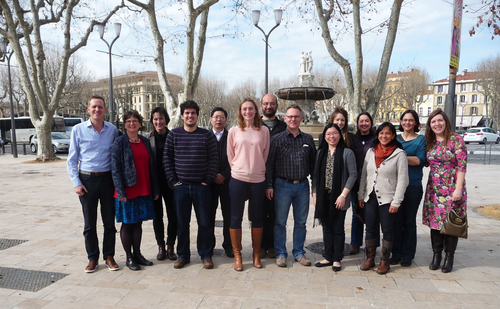
Participants at the workshop. Credit: Florian Wetzel
Topics on the agenda include:
The possibilities of visualisations like Aquamaps and Fishbase to provide information for Marine policy targets or for capacity building on marine biodiversity information. We were very happy to have Sandrine Vaz from IFREMER, Montpellier joining us as an expert on marine data and its policy context.
For the EU BON business plan, the next steps were defined for its development, part of which Pan Xingliang will explore in his masters project. One of the steps will include a strategy meeting with other initiatives and European projects that face the same challenge of ensuring life of their products and networks of knowledge after the project end date.
The objective of the third stakeholder round table was further defined based on lessons learned from previous stakeholder round tables and identifying the information needs from the data portal for EU BON from our EU BON test case study regions.
A recent paper by Duccio Rocchini et al. (2015) has been classified as the fourth hottest article in Ecological Informatics. The paper is part of the EU BON project, and discusses from a conceptual point of view, the potential of remote sensing in estimating biodiversity using various diversity indices, including alpha- and beta-diversity measurements.
Abstract:
Many geospatial tools have been advocated in spatial ecology to estimate biodiversity and its changes over space and time. Such information is essential in designing effective strategies for biodiversity conservation and management. Remote sensing is one of the most powerful approaches to identify biodiversity hotspots and predict changes in species composition in reduced time and costs. This is because, with respect to field-based methods, it allows to derive complete spatial coverages of the Earth surface under study in a short period of time. Furthermore, remote sensing provides repeated coverages of field sites, thus making studies of temporal changes in biodiversity possible. In this paper we discuss, from a conceptual point of view, the potential of remote sensing in estimating biodiversity using various diversity indices, including alpha- and beta-diversity measurements.
Original source:
Rocchini D, Hernández Stefanoni JL, He, KS (2015) Advancing species diversity estimate by remotely sensed proxies: a conceptual review. Ecological Informatics, 25: 22-28. doi:10.1016/j.ecoinf.2014.10.006
The second EU BON Roundtable took place on 27 November 2014 at the Museum für Naturkunde in Berlin. The workshop was dedicated to explore ways in which EU BON can support citizen science (CS) activities. Many partners and interested stakeholders participated, coming from different European research institutions, Natural History Museums, SMEs or representatives from European Institutions like European Commission (DG Research & Innovation and the Joint Research Centre) or the European Environmental Agency and EU-funded Citizen Observatories projects. On secondment to the Earth Observation Sector at DG Research and Innovation, European Commission, Jose-Miguel Rubio-Iglesias showed the possibilities of Citizen Science as one option to improve the science-society bridge. In the following interview he gives an overview of the topic covered and his participation at the round table.

Jose-Miguel Rubio-Iglesias gave a talk on improving the science-society-policy bridge by Citizen Science
Jose-Miguel Rubio-Iglesias, Policy Officer (Spanish National Centre for Geographic Information, on secondment to the European Commission)
Q: Where do you see the place of citizen science in the future of European research and innovation efforts?
A: I see a brilliant future of Citizen Science as a driver for research and innovation activities, especially in its shape of "Citizens' Observatories". The vertiginous increase in the use of mobile technologies, with a pervasive Internet accessible to everyone and social media usage at its peak, offers a world of opportunities for research and innovation in the domain of environmental monitoring technologies where citizens have a key role to play. Citizen science can also foster advancement in social innovation as these are normally collective actions carried out by citizens, sometimes in partnership with NGOs, researchers and public organisations, which are bringing benefits for the whole society. Furthermore, the European Union's Framework Programme for Research and Innovation, Horizon 2020, is already offering a framework to mainstream public engagement in science and research, from programming to implementation and evaluation, being citizen science a one of the key instruments to realise this objective. Data and information gathering, results interpretation and co-creation are examples of activities in which citizens can be involved, leading to different kinds of innovation, including social innovation.
Q: What are the success factors for citizen science? What are the challenges for Citizen Science on a European scale?
A: In my opinion there is no magic formula to achieve success in a citizen science activity, nor any plug-and-play solution. There are many variables that have to be considered, such as the thematic, spatial or temporal scope of the activity. But a common element that seems to be an ingredient for success is to plan carefully not only the process of engagement but the feedback mechanisms, so citizens realise their actions and the outcomes of what they have done are really being useful. Working on creating a strong perception of ownership is always a success factor on a voluntary initiative.
I see a number of challenges for Citizen Science at a European scale, especially, the need for a better coordination of the local and regional activities. This can avoid duplication of initiatives, foster best practices across activities and help position better citizen science vis-à-vis the EU and national and local governments, so citizen science can be higher up on their agendas. In this sense, I think the role of associations such as ECSA (European Citizen Science Association) is key in achieving this coordination.
Q: How can EU projects on biodiversity information like EU BON facilitate the process?
A: EU BON, like other EU projects which have biodiversity information as a focus, has an important role to make visible the knowledge treasured by citizen science groups. The European Biodiversity Portal, one of the EU BON main achievements, is a fantastic opportunity to open up the wealth of biodiversity data which has been collected by citizens throughout Europe, making it available for a better informed decision making in those areas in which biodiversity has a role.
Q: Where do you see the place of large European Earth observation projects such as EU BON in the global context?
A: The biodiversity information system resulting from EU BON is one of the main European contributions to GEO BON (GEO Biodiversity Observation Network), which is a flagship initiative of GEO (Group on Earth Observation). GEO BON is joining forces at international level to coordinate the activities relating to the Societal Benefit Area on Biodiversity of the Global Earth Observation System of Systems (GEOSS). Its main goals are to organize and improve terrestrial, freshwater and marine biodiversity observations globally and make their biodiversity data, information and forecasts more readily accessible to policymakers, managers, experts and other users. As EU BON is creating a stable and open-access platform for sharing biodiversity tools and data, taking stock of existing components such as LifeWatch or GBIF, this is clearly a step forward towards the fulfilment of the objectives of GEO BON.
At global level, EU BON and GEOBON are strategically positioned to contribute to delivery of data for the UN Convention on Biological Diversity (CBD) and the Intergovernmental Science-Policy Platform on Biodiversity and Ecosystem Services (IPBES).
Finally, together with EU BON, other large EU Earth Observation projects, such as SIGMA or Earth2Observe, are also providing an important contribution at global level to GEO, in this case to the GEO Societal Benefit Areas of Agriculture (GEO-GLAM) and Water respectively.
NOTE: The views expressed in this interview are only of the speaker and do not necessarily reflect the official opinion of the European Commission.
A new policy brief featured a recent issue of Science for Environment Policy highlights a new study suggesting that the Aichi biodiversity targets, set by the UN Convention on Biological Diversity, are unlikely to be achieved by 2020— despite some progress towards halting the global loss of biodiversity. The authors of the study call for policy responses to be strengthened if the ongoing loss of nature is to be stopped.
The loss of biodiversity affects the healthy functioning of ecosystems and the benefits they provide to people. The ongoing loss of the world’s natural diversity, which underpins all life, prompted Parties to the UN Convention on Biological Diversity (CBD) at the World Summit for Sustainable Development in 2002 to pledge reductions in the global decline in biodiversity by 2010.
The 2010 targets set by the CBD were missed. Consequently, a new set of goals to curb the loss of species and ecosystem services, supported by the 20 Aichi targets, were adopted by 193 nations in 2010. The Aichi targets, to be achieved by 2020, are part of the global Strategic Plan for Biodiversity 2011–2020.
A global panel of 51 experts, drawn from a wide range of institutions, has recently assessed mid-term progress towards meeting these targets. They based their assessment on an analysis of 55 indicators (for example, extent of wetlands) selected from 163 potential indicators, which are key measures of the world’s biodiversity. They built statistical models for each indicator, based on their status in 2010 and data trends and then projected changes to the indicators by 2020. The value for each indicator in 2010 was then compared with the projected value in 2020 to assess progression towards the 2020 Aichi targets.
Read more in the original SEP policy brief.
Original Study:
Tittensor, D.P., Walpole, M., Hill, S.L.L. et al. (2014) A mid-term analysis of progress toward international biodiversity targets. Science 346 (6206): 241- 244. DOI:10.1126/science.1257 484
The European Environment Agency (EEA) is organising an open competition with a view to recruiting a contract agent to work as Project Manager within the area of biodiversity indicators and assessments and further with a view to establishing a reserve list.
THE AGENCY
The EEA is an Agency of the European Union (EU) and one of the decentralised Union bodies. The EEA aims to support sustainable development and to help achieve significant and measurable improvement inEurope’s environment, through the provision of timely, targeted, relevant and reliable information to policy-making agents and the public.
More information is available on the official EEA page: http://www.eea.europa.eu/about-us/jobs/eeavacancy.2015-01-14.3625557226
A new paper describing the PREDICTS database has been published and is now available in open-access publication in Ecology and Evolution.
PREDICTS - Projecting Responses of Ecological Diversity In Changing Terrestrial Systems - is a collaborative project aiming to use a meta-analytic approach to investigate how local biodiversity typically responds to human pressures such as land-use change, pollution, invasive species and infrastructure, and ultimately improve our ability to predict future biodiversity changes.
Abstract:
Biodiversity continues to decline in the face of increasing anthropogenic pressures such as habitat destruction, exploitation, pollution and introduction of alien species. Existing global databases of species’ threat status or population time series are dominated by charismatic species. The collation of datasets with broad taxonomic and biogeographic extents, and that support computation of a range of biodiversity indicators, is necessary to enable better understanding of historical declines and to project – and avert – future declines. We describe and assess a new database of more than 1.6 million samples from 78 countries representing over 28,000 species, collated from existing spatial comparisons of local-scale biodiversity exposed to different intensities and types of anthropogenic pressures, from terrestrial sites around the world. The database contains measurements taken in 208 (of 814) ecoregions, 13 (of 14) biomes, 25 (of 35) biodiversity hotspots and 16 (of 17) megadiverse countries. The database contains more than 1% of the total number of all species described, and more than 1% of the described species within many taxonomic groups – including flowering plants, gymnosperms, birds, mammals, reptiles, amphibians, beetles, lepidopterans and hymenopterans. The dataset, which is still being added to, is therefore already considerably larger and more representative than those used by previous quantitative models of biodiversity trends and responses. The database is being assembled as part of the PREDICTS project (Projecting Responses of Ecological Diversity In Changing Terrestrial Systems –
Original Source:
Hudson L. N. et. al. (2014) The PREDICTS database: a global database of how local terrestrial biodiversity responds to human impacts. Ecology and Evolution, Vol 4, 24: 4701–4735. DOI: 10.1002/ece3.1303
The 2nd EU BON training on data sharing tools will take place side by side to CETAF/EU BON informatics workshops (see full program and logistic details here). The event will be organised by UEF and Digitarium, EU BON consortium member and work package leader (WP2), in collaboration with CETAF ISTC and other EU BON work packages.
Next topics will be covered:
- Introduction to GEOSS, GEO BON, EU BON (Hannu Saarenmaa)
- Information architecture of EU BON (Antonio Garcia)
- Data standards, Darwin Core and extensions for sample-based quantitative data (Éamonn Ó Tuama)
- Demonstration of GBIF/EU BON IPT for monitoring networks (Larissa Smirnova and Franck Theeten)
- Practical exercise with sample dataset (Larissa Smirnova and Franck Theeten)
- Practical exercise with own data (all trainees)
The workshop will include lectures and hands-on work, so participants are required to bring their own laptops. We will provide information and instructions on software installations. If the participants want to install IPT tool themselves, they can read and learn how to de it here. For the practical exercises it’s recommended to bring own data (taxonomic, monitoring).
Place and date: Joensuu, Finland, 19 March 2015
Venue: Joensuu Science Park, Digitarium and the Conference Facility "Network Oasis"
To register, please fill in the registration form
Find the event in our calendar here.
UNEP-WCMC, Dutch Butterfly Conservation, and EU BON recently convened a workshop of 14 global experts from the field of butterfly monitoring, specifically the tropics and subtropics. The workshop has catalysed the process for the development of global butterfly monitoring guidelines and the creation of a new specialist butterfly monitoring group.
Hosted by GEO BON (Group on Earth Biodiversity Observation Network) at the offices of the German Centre for Integrative Biodiversity Research (iDiv) in Leipzig, Germany, the meeting took place on 8th and 9th December 2014. The global experts attending the meeting shared their significant experience and knowledge from the tropics, sub-tropics and deserts; including countries such as Papua New Guinea, Belize, Brazil, Colombia, USA, South Africa, Malaysia, and Liberia.

Blue Copper (Lycaena helle); Credit: Chris van Swaay
Butterfly populations have been monitored in Europe for over 35 years. This monitoring has used standardized protocols, produced long-term datasets, and has resulted in indicators tracking the changes in butterfly populations. These data are proving to be very valuable for informing decision-makers on biodiversity changes and are used at local, national and regional levels to inform conservation management decisions and policies. As a result of the success of schemes in Europe, butterfly monitoring is growing and is now being implemented in countries outside of Europe including North America and Israel using similar protocols.
However, the protocols for butterfly monitoring in temperate regions are not applicable in regions with high numbers of butterfly species such as the tropics. In these biomes methodologies such as fruit-bait traps, counts of puddling butterflies, and timed counts have been used. The aim of this meeting, therefore, was to agree a standard set of methodologies that could be applied globally and from which data could be aggregated through an Essential Biodiversity Variable into a Global Butterfly Indicator.
The main agenda items and points of discussion were an overview of current butterfly monitoring, structured by continent and habitat, with emphasis on the different protocols; steps to process count data into indicators and trends; essential variables required to measure changes in butterfly populations; compatibility of different protocols and the logistics of creating a global indicator; whether the entire species diversity should be measured or just a portion; and agreement on a standard set monitoring protocols.
This workshop has catalysed the development of a number of products, including: global butterfly monitoring guidelines; the development of a Global Butterfly Indicator; and a suite of scientific journal articles on butterfly monitoring in different regions of the world. The development of an Essential Biodiversity Variable (EBV) ‘butterfly population abundance’ that will facilitate the harmonisation of butterfly monitoring data from different habitat types and regions is also being developed. A new butterfly monitoring specialist group has also been established to provide support for practitioners working in the field of butterfly monitoring and to continue momentum from this workshop.
The standardization of monitoring protocols that can be implemented in any country is crucial for the robust estimation of butterfly populations globally to assess progress towards the 2020 targets of the Convention on Biological Diversity (CBD). These guidelines can also provide the foundation for developing scenarios for the future of butterfly populations under different policy and management options. The outcomes of this meeting provide a clear path to increased harmonization among the efforts of global butterfly experts in different regions and towards the establishment of a Global Butterfly Indicator.
We would like to thank GEO BON and EU BON for funding this meeting.

Participants of the butterfly monitoring experts meeting at iDiv, Leipzig, Germany, December 2014
A second WP4 (Link environment to biodiversity: analyses of patterns, processes and trends) meeting was held on 8 & 9 December 2014 in Brussels, to discuss progress towards objectives and set plans for future development.
Hot topics during the meeting were: GBIF data: who will use them, and how; development and use of methodology; collaboration between WP4 and the relevant WP3 (Improving tools and methods for data analysis and interface) and WP5 (EU BON testing and validation of concepts, tools, and services); as well ways to translate WP4 results for the use of policy and practice.
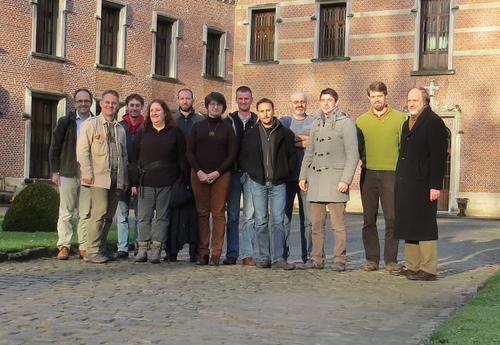
Image: Participants at the meeting; Credit: Dirk Schmeller
A Memorandum of Understanding (MoU) was signed at the second EU BON Stakeholder Roundtable on Citizen Science between Christoph Häuser, on behalf of EU BON, and Fermin Serrano Sanz, on behalf of the Citizen Science Project Socientize at the 27th of November 2014. The Roundtable on Citizen Science took place at the Museum für Naturkunde in Berlin, Germany and followed the General Assembly Meeting of the European Citizen Science Association.
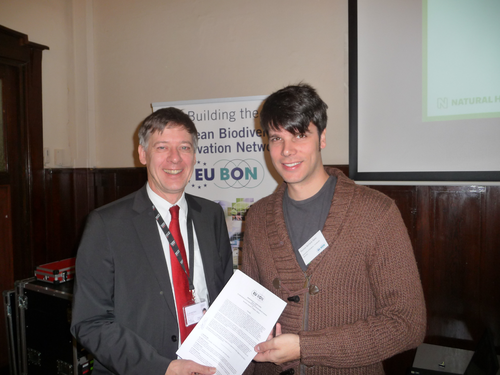
Signing the MoU: (left) Christoph Häuser, EU BON and (right) Fermin Serrano Sanz, Socientize
Socientize (Society as e-Infrastructure through technology, innovation and creativity) is a Citizen Science Project that was funded by the European Union. The project aims to coordinate agents involved in the citizen science process and to foster and promote the usage of citizen science infrastructures. There are several linkages between the citizen science related work of EU BON and Socientize (e.g. policy recommendations for citizen science) and by signing the MoU, a further exchange and follow-ups were agreed.
The second EU BON Roundtable took place on 27 November 2014 at the Museum für Naturkunde in Berlin. The workshop was dedicated to explore ways in which EU BON can support citizen science (CS) activities. EU BON is building a large integrated biodiversity information infrastructure in order to serve science, policy and administration as well as citizen scientists. Citizen scientists are important stakeholders, as they support the increase of knowledge in various aspects, they may debate research questions, most often they collect data, and they may interpret data and publish their results.
Many partners and interested stakeholders participated, coming from different European research institutions, Natural History Museums, SMEs or representatives from European Institutions like European Commission DG Research & Innovation, the European Environmental Agency or the JRC and EU-funded Citizen Science projects.
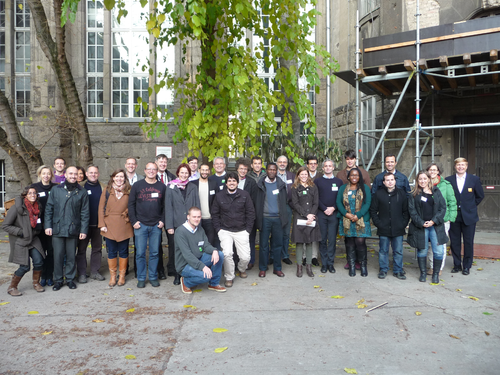
Participants at the 2nd EU BON Stakeholder Roundtable
The Citizen Science Roundtable started with a "Setting the scene" session where a welcome address was given by Katrin Vohland from the Museum für Naturkunde (MfN). In a brief introduction from a biodiversity data perspective, some gaps in current bio-diversity data were shown, for example the large data gaps in Eastern European data in plant datasets and the restricted access to many datasets. Christoph Häuser from the MfN outlined EU BON and its main activities in the field of Citizen Science.
As a representative from DG Research and Innovation from the European Commission, Jose-Miguel Rubio-Iglesias showed the possibilities of Citizen Science as one option to improve the science-society bridge. Lucy Robinson (ECSA/NHM London) focused on citizen science in Europe, its impact and development.
The next session targeted the question of how EU BON can possibly support data mobilization of and for citizen scientists. Antonio García Camacho from CSIC Donana showed, with a colleague from IBM, the prototype of the future EU BON data portal, to integrate biodiversity data/metadata sources into a single user interface. In another talk, Jaume Piera pointed out the requirements that exist in a CS portal, e.g. with regards to the role of citizen collaboration, the social media channels, and particularly the conceptual requirements. Important aspects here are for example that data access tracking has to be guaranteed, for giving credits to data producers and for keeping track of data use. Simao Belchior of the SME Simbiotica showed successful ways of visualizing georeferenced data, e.g. the mapping of pan-tropical forest clearing.
The next session called "A spotlight on some (meta)data provider" was started by Veljo Runnel who presented an assessment of Citizen Science involvement in biological research. Nils Valland described in his talk key success factors for citizen science and species occurrence data in Europe. Dirk Schmeller informed the audience about Volunteer Species Monitoring in Europe. He pointed out the need that governments should invest more to support and expand current monitoring initiatives. For example the EuMon project had documented 395 monitoring schemes for species, which represents a total annual cost of about €4 million, involving more than 46,000 persons devoting over 148,000 person-days/year to biodiversity monitoring activities.
In the "Synergies of European Citizen Science projects" session, presentations outlined of the main aims of several EU funded Citizen science projects (Citclops, COBWEB, Socientize). Pierre-Philippe Mathieu from the European Space Agency highlighted the new era for Earth Observation and links to Citizen Science projects. Siro Masinde from showed the Citizen Science activities of GBIF, which is one of the largest data providers of species occurrence records.
For more detailed information on the issues discussed, please see below the presentations from the meeting or contact us:
Dr. Katrin Vohland ( katrin.vohland@mfn-berlin.de)
Dr. Florian Wetzel (florian.wetzel@mfn-berlin.de)
PRESENTATIONS
1.Rubio-Iglesias - Citizen Science as science-society bridge
3. Robinson - Citizen science in Europe
4. Camacho - EU BON biodiversity portal
5. Piera - Requirements for the EU BON biodiversity
6. Belchior - Fall of data portals and future of data workflows
7. Runnel - Assessing Citizen Schience involvement
8. Arvanitidis - Crowdsourcing initiatives in the Mediterranean Basin
9. Valland - Key success factors of citizen science
10. Schmeller - Volunteer Species Monitoring
11. Mathieu - Crowd Sourcing for Space Science
15. Masinde - GBIF, plans for integrating Citizen Science data
Selection of pictures from the meeting:

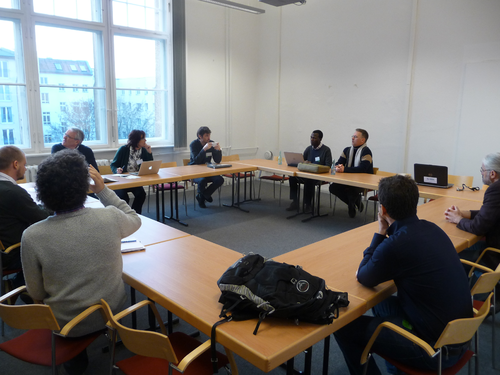
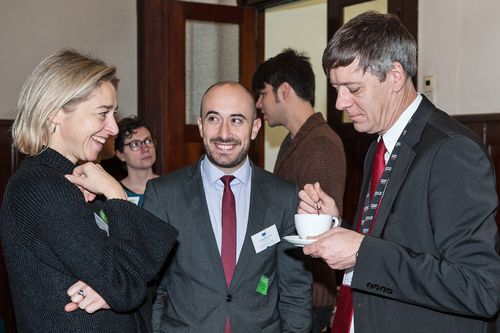
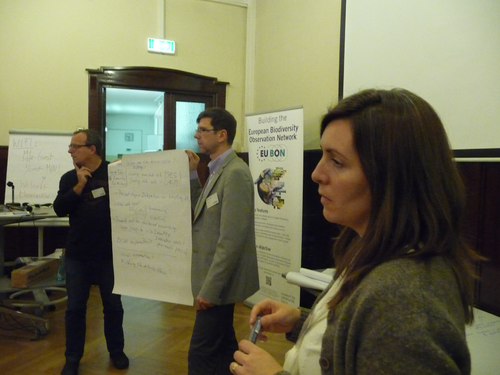
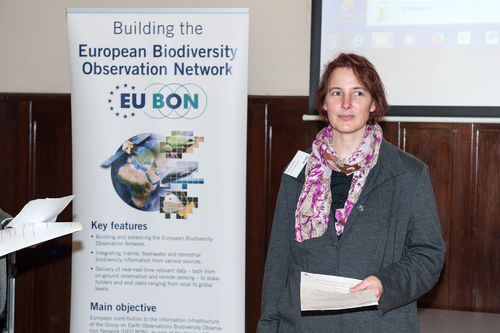




 RSS news
RSS news




